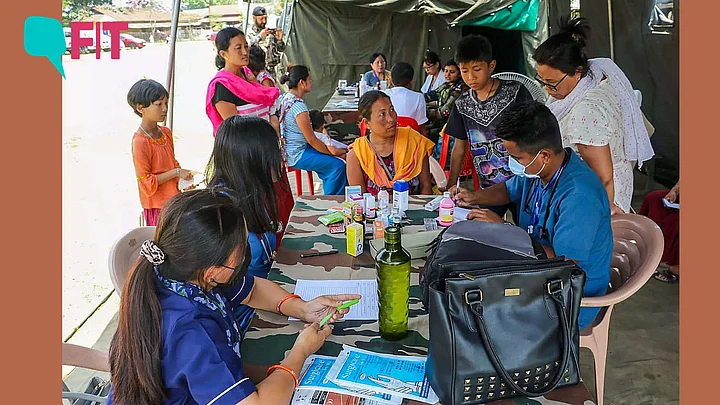"My father has been undergoing chemotherapy in the Churachandpur District Hospital. The frequency has reduced from once a week to once in 10-12 days since the violence broke out in Manipur," the 30-something daughter of a patient in his sixties told The Quint, on the condition of anonymity.
"I fear that his condition will deteriorate if he does not see an oncologist. We are considering ways to leave for Aizawl [Mizoram], because it looks like things won't get better any time soon."
The 54-year-old wife of another patient – who's suffering from kidney problems and had been getting dialysis from the same hospital – said, "We are from Churachandpur – but we have lost our house. My husband does not have proper access to nutrition. I think as a family, we are mentally preparing for the worst. I don't have anything else to say."
Located nearly 65 km away from Manipur's capital Imphal, Kuki-dominated Churachandpur district has been at the centre of the ongoing ethnic violence in the state, which broke out on 3 May.
The Churachandpur District Hospital is the only multi-specialty government hospital in the region, where nearly 108 relief camps have been set up and about 15,000 people who have been displaced have taken shelter.
Apart from providing critical care to kidney and cancer patients, the hospital has been tending to emergency cases from the violence. In the last two months, until 24 July, the hospital had treated as many as 288 bullet injuries from the clashes. During the same period, the hospital has delivered 78 babies and provided them with post-natal care.
"We are running out of medicines to treat people. We have been using local funds and donations to procure whatever drugs we can. But for how long?" asked a medical officer at the Churachandpur District Hospital.
The Quint has reached out to the Manipur government over release of funds and drugs to Churachandpur District Hospital. The article will be updated as and when they respond.
Why Is Churachandpur Burdened?
After the ethnic clashes broke out, the movement of essential commodities and medical supplies via the crucial NH2 (National Highway-2) has been hindered by protesters. Several sections of the highway have been blocked by protesting Meitei and Kuki groups time and again over the course of the past three months now. [THERE IS BLOCKADE WHICH IS LIFTED, BUT AFTER EVERY FRESH VIOLENCE IT IS BROUGHT BACK. WE NEED TO KEEP THIS GENERIC UNLESS WE CAN TRACE WHAT WAS BLOCKED WHEN].
The NH2 connects XXXXXX CAN WE PLEASE ADD A LINE?
According to the medical officer, Churachandpur still remains in a vulnerable position – with essential supplies cut off to the district. This includes drugs and medication for those affected by the violence.
This also means that patients in and around Churachandpur cannot access the Regional Institute of Medical Sciences (RIMS) in Meitei-dominated Imphal Valley, increasing further dependance on the district hospital.
"No access to RIMS means no access to healthcare. You have to understand that access to healthcare, even under normal circumstances, is a challenge for those living in the hilly regions of Manipur – which mostly has Kukis or the tribal population," Dr Lhainunhoi Khongsai, a Manipur native who is pursuing her Masters in a Delhi hospital, told The Quint.
How Is the Hospital Managing?
The Central government sent two doctors to Churachandpur from All India Institute Of Medical Science (AIIMS), Guwahati, earlier in June, as part of six teams of doctors sent across violence-ridden Manipur. [WHERE DID THE OTHER FOUR GO?] But what the hospital needs right now is doctors who can help patients with chronic illnesses.
"The last time an oncologist must have come to Churachandpur was maybe the end of April. Since then, he has taught the nurses over phone, as to how to provide chemotherapy. The nurses, with our help, have been catering to the needs of the patients," a physician in Churachandpur District Hospital, who wished to be anonymous, told The Quint.
"For example, we already have patients who need dialysis. But now, we have additional people who are in relief camps. Normally, these people would have gone to Imphal. We have only three dialysis machines, but I don't know how many patients need these. We have made a roster of patients, some may be getting treatment less frequently than before the violence," the physician at the Churachandpur hospital added.
'Please Release Funds for Medicines'
Doctors at the district hospital say that while the lack of manpower is something they can still manage with medical students from the region pitching in, they can't manage without medicines and surgical equipment.
"The rich have already shifted to Aizawl or they are capable of procuring medicine need for treatment from Mizoram and Assam. But I really urge the government to help us with funds with which we can procure medicines," the medical officer said.
"We were promised that they will airlift some medicines but that has not happened. I don't know how to stress that we are running out of medicines. Prices of everything have more than doubled. We need urgent supplies for treatment."
Even in the midst of crisis, the Churachandpur District Hospital has been organising a once-a-week camp across the relief camps to identify patients in need and provide them with care.
"We try and cater to as many patients as possible. Not everyone can afford private care. I hope we are heard," the medical officer added.

